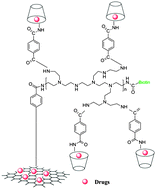Functional materials from the covalent modification of reduced graphene oxide and β-cyclodextrin as a drug delivery carrier†
Abstract
We report a drug delivery system based on the covalently reduced graphene oxide (rGO) with p-aminobenzoic acid (rGO-C6H4-COOH) for the loading and targeted delivery of the anticancer drug, doxorubicin (DOX). The colloidal solution of rGO-C6H4-COOH conjugated by polyethyleneimine (PEI) and Biotin was prepared. This endows the colloidal solution of rGO-C6H4-CO-NH-PEI-NH-CO-Biotin, which presents excellent water-solubility and targeting as a drug delivery system. β-Cyclodextrin (β-CD) molecules, which are host molecules for accommodating guest molecules, such as water insoluble anticancer drugs, were introduced to reduce the cytotoxicity of the drug delivery system and to improve the biocompatibility. The drug delivery of rGO-C6H4-CO-NH-PEI-NH-CO-CD-Biotin has a ∼24.64% drug (DOX) loading ratio. The drug release behavior was pH dependent at higher DOX concentrations, but salt dependent at lower DOX concentrations, which could be exploited for controlled drug release in cancer cells. The DOX loaded on rGO-C6H4-CO-NH-PEI-NH-CO-CD-Biotin could effectively induce HepG2 cancer cell apoptosis. This can be explained by the conjugation of DOX and rGO-C6H4-CO-NH-PEI-NH-CO-CD-Biotin being able to arrest the cancer cells in the G2 phase, which is the most sensitive to the anticancer drug.


 Please wait while we load your content...
Please wait while we load your content...